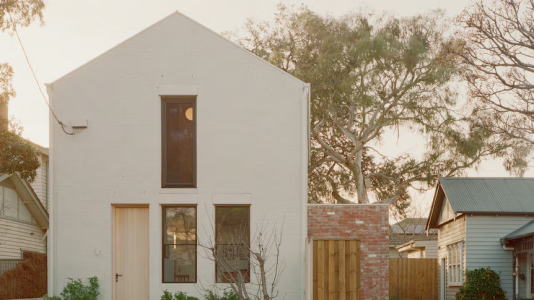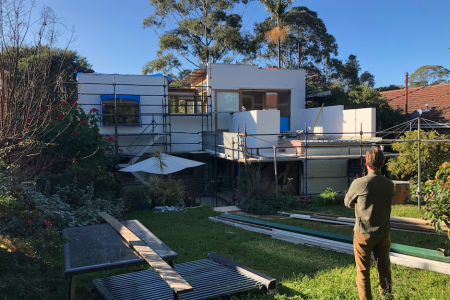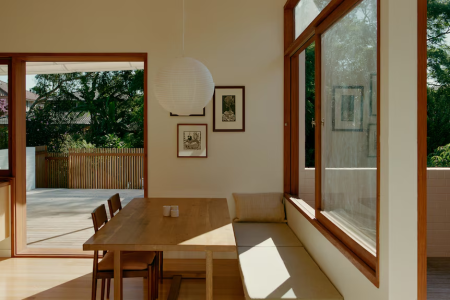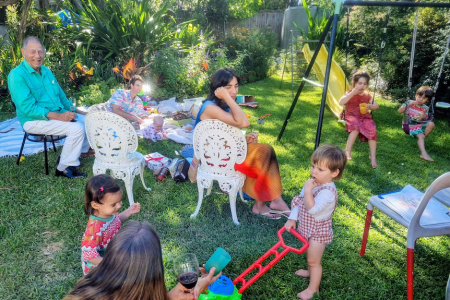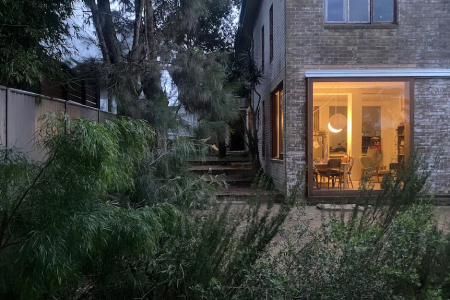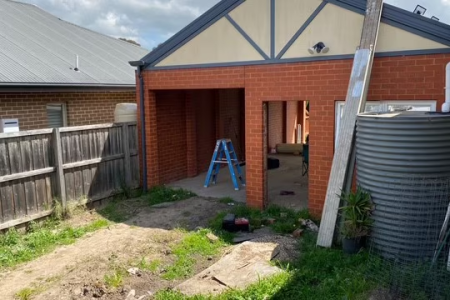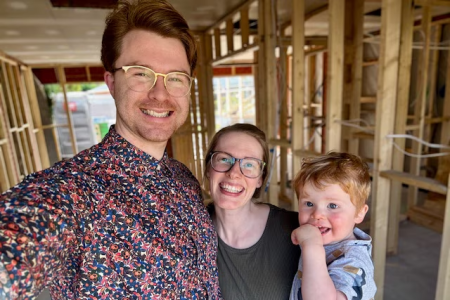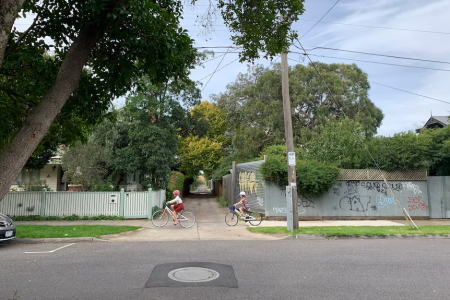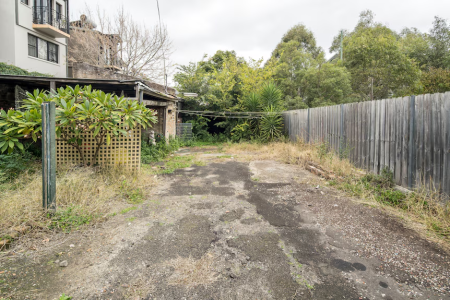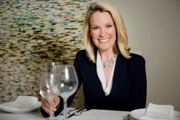As property prices rise, so are home renovations for multi-generational living
By
ABC News
- Replies 0
In a wealthy, riverside suburb of Sydney they built an architecturally designed house for under $900,000.
"It's a huge bargain," Georgia Booth says of the airy three-bedroom brick home she moved into nearly five years ago with her partner Adam Farrow-Palmer.
The catch? The house sits on top of her in-laws' house.
When the couple considered buying their own home, Booth says they realised anything remotely close to Sydney's inner city was beyond their budget. Building on their parents' block was a tempting solution. While $900,000 is a sizeable amount of money, Sydney's median house price was $1.2 million the year they built. In their suburb, Lane Cove, the median house price was $2.6 million when they built and is now $3.2 million.
But their motivations weren't purely economic. "The mutual benefit of Adam's parents helping us with our future kids and us being able to help as they got older and needed a bit more assistance was appealing,” Booth says.
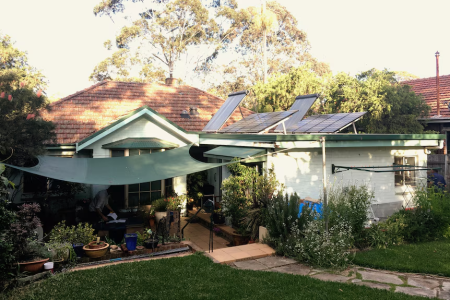
The original house at Lane Cove before Georgia Booth and Adam Farrow-Palmer added a three-bedroom house above it. (Supplied: Harry Catterns)
As more Australians rely on family support to enter the housing market, the backyard of mum and dad is becoming an option. For some members of the so-called "boomerang generation" returning to live with family isn't a choice but a necessity in hard economic times. For others, multi-generational living in the form of renovations, second dwellings and granny flats is a positive twist on the tired, sad tale of Australia’s housing crisis which is providing social, economic and environmental benefits.
Since Booth and Farrow-Palmer's "Lane Cove House" won national architecture awards and widespread media attention in 2023, the architects behind the project have been fielding calls about creating similar projects.
"There are a lot of people in Sydney in their 30s who are faced with the options of either moving out of the city or trying to work out a way to leverage the asset that their parents bought at a time when it was more feasible to do such a thing," says Harry Catterns, co-founder of SAHA architecture studio.
Catterns says SAHA has completed three multi-generational or co-housing projects and has another four currently in progress.
'Not without risk'
By building above the original house, Catterns says Lane Cove House preserves the garden, capitalises on the views and provides privacy for both households. He believes the house is a great template for what can be achieved on a typical suburban block.
But it's not without risk. The new dwelling is technically an addition to the existing one. What if the couple divorced, or Adam's parents wanted to move out?
"We had a lot of difficult conversations going into this," Booth says — and there were no easy answers. She also had to consider the implications of multi-generational living. Could she live with her extended family, would it be an imposition on them, would she feel like she didn't have her own space?
Several years on, she says the experience has been overwhelmingly positive. There are impromptu conversations in the backyard over juicy homegrown fruit, the sharing of neighbourhood gossip, an open pantry policy, and the singular, boundless joy that exists between grandparents and their grandchildren.
"There's easy access between upstairs and downstairs which means some mornings my five-year-old daughter will wake me up and say, 'Can I go downstairs and have breakfast with Nana?' And I can say, 'Yeah' without getting out of bed and she will take herself down and just hang out … with her grandparents which is so beautiful," she says. "And I still feel like I have my own space."
The negatives? "If I have a fight with my partner, as everyone does, I sometimes think, 'Oh, did they hear that?'," she says. "Occasionally we have different desires about what we want to do with the shared spaces like the backyard."
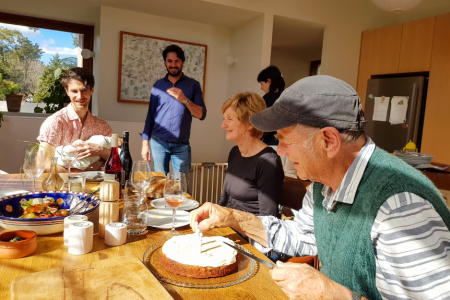
Booth says the house is a beautiful place to live and has given them the opportunity to be close to Sydney and family. (Supplied: Harry Catterns)
The Airbnb effect
Catterns says these types of additions to existing houses improve density in established suburbs without ruining their character.
Australian cities are some of the most sparsely populated in the world. Increasing density can help reduce urban sprawl and improve access to the services and infrastructure — like public transport, schools and jobs — that exist in established suburbs, which in turn leads to shorter commutes and lower emissions.
At his own house in Malabar, (which he purchased with help from the bank of mum and dad) Catterns and his partner converted a cavernous six car garage — once owned by a race car driver — into a second home which they rent out to friends at half the market rate.
Adding more people to the block has improved their quality of life, not diminished it. "We have a young boy, and the family downstairs have two young kids and we're sharing care between them, taking the pressure off each other… [and] living in a socially connected way, sharing dinner and sharing meals," he says. "I think it's an incredibly enriching way to live."
But getting additional dwellings to existing blocks approved can be difficult.
"In my experience, in terms of the complaint letters that we see, people are very scared that a secondary dwelling is going to be used as a really transient rental property for Airbnb, which comes with all the fear around parties," Catterns says.
"But the parking is the thing that stops a lot of projects from happening."
A granny flat isn't always for a granny
When Nola Young hears her two-year-old grandson playing in the backyard it fills her with happiness. Six months ago, her son and his family moved into what had been a large brick garage on the quarter-acre property she shares with her husband Alan on Melbourne's northern fringe.
Young says her son and his wife were renting and "could barely keep their head above water" let alone save for a house deposit. So, when new granny flat laws came into effect in Victoria in 2023 they decided to act, spending $120,000 to convert the garage into a home.
"We were very frugal," Young says. "We can't provide gold taps and mansions; it's a very humble house, and a very small house. But it is a roof over their head and it's a step up for them and its stable accommodation and they love it."
But care flows in both directions, says Young, who looks after her grandson one day a week. There are shared meals, errands run and for Young, who uses a wheelchair, the comfort of knowing family is nearby when her husband is out.
Young says they wanted to help their son when he needed it most, rather than waiting until later in the form of an inheritance. But helping one son means assisting their other son — something they're still figuring out how to do. "You must be fair," Young says. "As parents you need to be."
Exactly how long her son and his partner will live in the garage-turned-granny flat is unknown, but for now, Young says it's a great solution in tough economic times.
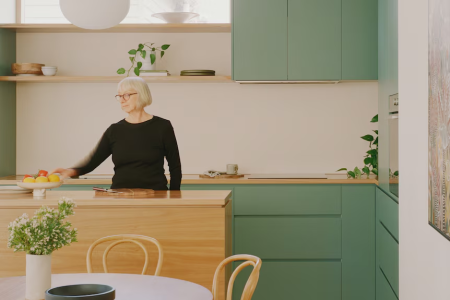
Maddy McMaster says her new two-bedroom house in Northcote means she will be able to stay in the community she loves for longer. (Supplied: Pier Carthew)
The house swap
Several suburbs away, another Melbourne family is accommodating two generations of adults on one block.
Maddy McMaster has lived in a five-bedroom Edwardian house in a leafy Northcote street since 1994. It's the house she shared with her late husband. The place they raised their children and built a life.
Rambling around the large old home didn't seem like a sensible future for McMaster but neither did leaving the suburb and community she loves. She'd often dreamed of building a small house at the back of her block. "But that was a bit of a fantasy," she says — until her son suggested that he could fund the build and move into the house. "So that's what we did."
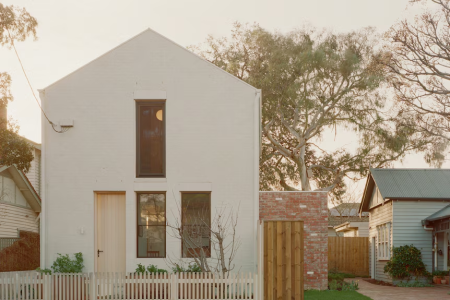
The two-storey house is designed so that it can be inhabited solely on the ground floor if needed. (Supplied: Pier Carthew)
Her son spent $800,000 building a small two-bedroom dwelling which faces the side street. It's not a "cheap" build, but McMaster now has a modern, comfortable house designed for aging in place.
"I'm about to turn 70 and … it's fantastic to think that I'll actually be able to stay longer in my own house because I have got that support right next door," she says.
Being able to live in the inner-city suburb also appeals to her son and his partner. "The idea of paying a couple of million dollars now to live in this part of Northcote is way beyond your average 30-year-old," McMaster says.
Treating both her children fairly is something McMaster says she's sorting out in her will — which will allow her son to stay in the old house and account for the money he has invested in the second dwelling. McMaster says her daughter lives overseas and "is really happy that I'm going to be getting older with support, when she's actually not able to help me from New Zealand".
Architect Ben Callery, who designed McMaster's house, says putting multiple families on one property has many benefits. "It's increasing the density, which is a much more sustainable use of our land," he says. "We're able to build something new that's much more high-performance energy wise and socially… we can keep people in their existing communities rather than move them out to an aged care facility."
Michael Fotheringham, managing director of the Australian Housing and Urban Research Institute, says there's a general shift occurring in different jurisdictions to increase infill development. What's often referred to as the "missing middle" — medium density development such as town houses, secondary dwellings and low-rise apartment buildings.
But there is little data available on how many of these developments are for intergenerational living, he says. Whatever the numbers, he argues, every little bit helps. "I think we need to move past the notion that there is a single thing we can do that will solve the problem, that there is one policy lever that will fix the housing challenges we have," he says.
"We need to be thinking well, is this a positive step, will this work towards a better solution?"
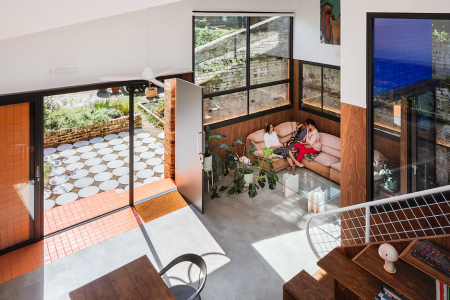
Qianyi Lim and her mother in the lounge of her house in Forest Lodge. Lim says a double-height living area gives the small footprint home a feeling of space.
Multi-generational spaces beyond the home
Infill development, especially in the form of multi-generational living, requires compromise and space is often the first thing jettisoned.
When architect Qianyi Lim purchased a 360sqm block of land in inner Sydney with a weatherboard cottage at the front and a dilapidated stable at the back, her intention was always to build two family homes on it.
One home for her family and one for her sister's family. While sharing the cost of the project had economic benefits, the sisters wanted to recreate the type of multi-generational living — and the sense of community — their mother experienced growing up in Malaysia.
Lim's mother had lived in a multi-level house above a shop overflowing with family whose lives, dreams and futures were interconnected. "The stories that we heard from that sounded incredible, dinner was eaten in rounds," she says.

Qianyi Lim's home looks onto a shared courtyard with the second dwelling, which is due to be constructed lated this year. (Supplied: Katherine Lu)
Living in the inner city means the families don't need a lot of space, she says. "We're out in the parks and we don't need a huge backyard to ourselves because the city of Sydney provides these incredible playgrounds that are far more exciting for our children than hanging out in a small patch of grass," Lim says.
Lim also wants to see Australia embrace the design of intergenerational spaces such as early learning sites mixed with aged care facilities or student housing. "There's so many benefits in bringing the older generations and younger generations into the same space," she says. "I think it would be great to see that brought to Australia because we also have a very big issue with providing quality care for older citizens."
On the home front, Lim says multi-generational living will most likely flourish in the future. She says more people are approaching her interested in designing homes for diverse family groups. "This type of housing is definitely on the rise."
Written by Rhiannon Stevens, ABC News.

